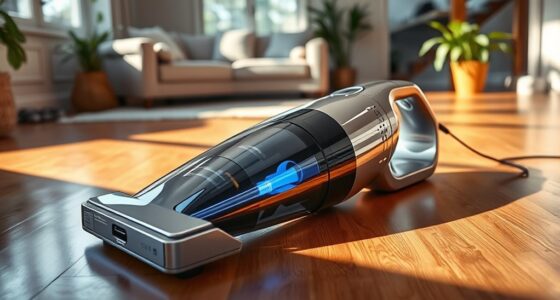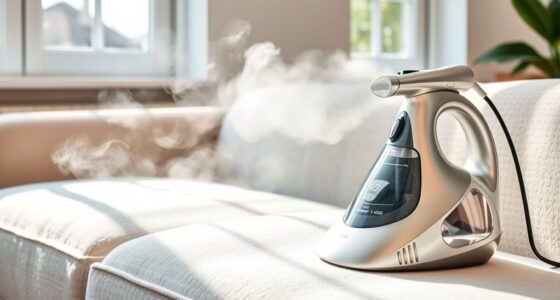Using vacuums with HEPA filters and dehumidifiers can greatly help control dust mites in your home. The vacuum captures allergens like dust mites and their waste, while the dehumidifier keeps humidity levels below 50%, preventing mite growth. Regular vacuuming and maintaining low humidity improve your air quality and reduce allergy symptoms. Together, they create a healthier environment. Discover more ways to enhance your home’s comfort and reduce allergens effectively.
Key Takeaways
- Using a vacuum with a HEPA filter reduces dust mite allergens in carpets, upholstery, and bedding, enhancing overall air quality.
- Dehumidifiers lower indoor humidity levels below 50%, inhibiting dust mite growth and creating a less hospitable environment for them.
- Regular vacuuming combined with dehumidification helps maintain cleaner surfaces and reduces allergen buildup effectively.
- Position air purifiers alongside vacuums and dehumidifiers to capture airborne dust mite debris for improved indoor air quality.
- Implementing a consistent cleaning routine, including washing bedding and using allergen-proof covers, maximizes dust mite control efforts.

If you’re struggling with allergies or asthma, controlling dust mites in your home is essential. These tiny creatures thrive in warm, humid environments, making your living spaces their perfect habitat. You can considerably reduce their presence by using vacuums and dehumidifiers in tandem. This combination aids in creating an inhospitable environment for dust mites, leading to better air quality and fewer allergy triggers.
First, you’ll want to invest in a vacuum that’s equipped with a HEPA filter. These filters are specifically designed to trap allergens, including dust mites and their waste products. When you vacuum, make sure to focus on areas where dust mites are likely to accumulate, such as carpets, upholstery, and bedding. Regular vacuuming can help you remove dust and allergens before they settle back into your environment. It’s best to vacuum at least once a week, and more often if you have pets or a high dust accumulation.
Invest in a HEPA filter vacuum to effectively trap dust mites and allergens, focusing on carpets, upholstery, and bedding. Regular vacuuming is key!
Next, consider the air purifier integration in your home. An air purifier with a HEPA filter can work wonders alongside your vacuum. While the vacuum removes allergens from surfaces, the air purifier captures particles circulating in the air, including any dust mite debris that might become airborne. Position the air purifier in commonly used areas, such as bedrooms or living rooms, to maximize its effectiveness. Running it continuously can help maintain cleaner air, reducing your allergy symptoms.
Don’t underestimate the importance of humidity control in dust mite management. Dust mites thrive in humid conditions, so using a dehumidifier is vital. Aim to keep humidity levels below 50% to deter dust mites. Place the dehumidifier in areas prone to moisture, like basements or bathrooms. You’ll notice a considerable difference in how your home feels and smells, and your allergies may improve as well. Additionally, consider incorporating music therapy into your routine, as it can enhance emotional well-being and help reduce stress related to allergy symptoms.
Lastly, incorporate allergen removal techniques into your cleaning routine. Wash your bedding in hot water weekly to kill dust mites and their eggs. Use allergen-proof covers for pillows and mattresses to create a barrier against these pests. By combining regular vacuuming, effective air purifier integration, and humidity control with a dehumidifier, you’re setting yourself up for success in managing dust mites.
Taking these steps can lead to a healthier home environment. You’ll breathe easier, sleep better, and enjoy life with fewer allergy symptoms.
Frequently Asked Questions
How Often Should I Vacuum While Using a Dehumidifier?
You should vacuum at least once a week to effectively remove dust mites from your home. If you have allergies or pets, consider increasing your vacuum frequency to two or three times a week. Regular vacuuming helps keep dust mites and allergens at bay, ensuring a healthier environment. Using a vacuum with a HEPA filter can enhance dust mite removal, so make sure yours is equipped for the best results.
Can Dehumidifiers Reduce Allergens Other Than Dust Mites?
Yes, dehumidifiers can reduce allergens like mold and pet dander. Imagine your home feeling fresher after you’ve run your dehumidifier for a few hours. You notice less sneezing and coughing, and you realize the humidity’s dropped. This creates an environment less conducive to mold growth and helps control pet dander, making it easier for you to breathe. So, by managing humidity levels, you’re actively improving your indoor air quality and comfort.
Do Different Vacuum Types Affect Dust Mite Control?
Yes, different vacuum types can substantially affect dust mite control. When you choose a vacuum with good filtration, like HEPA, you’re better at trapping allergens. Consider your carpet types too; dense carpets can hold more dust mites, so a vacuum designed for deep cleaning is essential. Regularly using the right vacuum not only reduces dust mites but also improves your overall indoor air quality. Make sure to vacuum frequently for the best results!
Is It Safe to Run Both Devices Simultaneously?
Yes, it’s safe to run both devices simultaneously. In fact, doing so can enhance your indoor air quality. Just keep an eye on moisture levels; running a dehumidifier alongside a vacuum can help maintain a balanced environment. Confirm your vacuum’s filters are clean to avoid blowing dust back into the air. You’ll create a more effective dust mite control strategy, improving your overall home comfort and safety.
How Can I Maintain My Vacuum for Optimal Performance?
Maintaining your vacuum’s performance is like keeping a car tuned for a smooth ride. Regularly check your vacuum bag; replace it when it’s two-thirds full to ensure strong suction. Stick to a filter replacement schedule—typically every 3-6 months, depending on usage. Clean the brush rolls to prevent clogs, and inspect the hose for blockages. With these steps, you’ll keep your vacuum running efficiently and extend its lifespan.
Conclusion
In the battle against dust mites, vacuums and dehumidifiers are your dynamic duo. While vacuums suck up allergens, dehumidifiers create an unwelcoming environment for those pesky pests. It’s like having a bouncer at the door, ensuring dust mites can’t crash your home. By combining these two tools, you’re not just cleaning; you’re actively improving your indoor air quality. So, embrace the power of this partnership and enjoy a fresher, healthier living space free from unwanted guests!









